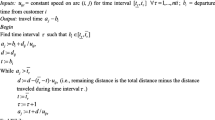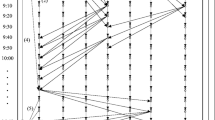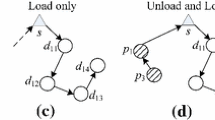Abstract
Efficient insertion heuristic algorithms allowing multi trips per vehicle (EIH-MT) and allowing a single trip per vehicle with post-processing greedy heuristic (EIH-ST-GH) are proposed to solve the multi-trip inventory routing problem with time windows, shift time limit and variable delivery time (MTIRPTW-STL-VDT) with short planning horizon. The proposed algorithms are developed based on an original algorithm with two enhancements. First, the delivery volumes, the associated beginning delivery times and the exact profits are calculated and maintained. Second, the process to finalize a best-objective and feasible solution is developed. These algorithms are shown to have the complexity of O(n4). These heuristics maximize the profit function, which is the weighted summation of total delivery volume and negative total travel time. EIH-MT and EIH-ST-GH are performed on 280 instances based on Solomon’s test problems with three weight sets. Best-objective solutions are examined to illustrate the feasibility of various constraints. The trade-offs between total delivery volume and total travel time are observed when varying weight values. There is not a single winner heuristic based on the number-of-vehicles, profit and CPU criteria across the three customer configuration types. On average performance, EIH-ST-GH is preferred over EIH-MT for cluster configuration type with the following average improvement percentages: 1.03% for profit, 2.93% for number-of-vehicles and 38.68% for CPU. For random and random-cluster configuration types, EIH-ST-GH should be preferred because of better profit (0.27% for random and 0.22% for random-cluster) and CPU (46.96% for random and 44.06% for random-cluster) improvements. In the comparison of the multi-trip algorithms against the single-trip algorithm, the benefits in reducing the number of vehicles on-average are shown across all customer configuration types.


Similar content being viewed by others
References
Aksen D, Kaya O, Salman F, Akca Y (2012) Selective and periodic inventory routing problem for waste vegetable oil collection. Optim Lett 6(6):1063–1080
Alegre J, Laguna M, Pacheco J (2007) Optimizing the periodic pick-up of raw materials for a manufacturer of auto parts. Eur J Oper Res 179(3):736–746
Andersson H, Hoff A, Christiansen M, Hasle G, Lokketangen A (2010) Industrial aspects and literature survey: combined inventory management and routing. Comput Oper Res 37(9):1515–1536
Ando N, Taniguchi E (2006) Travel time reliability in vehicle routing and scheduling with time windows. Networks and Spatial Economics 6(3–4):293–311
Angulo A, Nachtmann H, Waller MA (2004) Supply chain information sharing in a vendor managed inventory partnership. J Bus Logist 25(1):101–120
Brandao J, Mercer A (1997) A tabu search algorithm for the multi-trip vehicle routing problem. Eur J Oper Res 100:180–191
Campbell AM, Savelsbergh MWP (2004a) Efficient insertion heuristics for vehicle routing and scheduling problems. Transp Sci 38(3):369–378
Campbell AM, Savelsbergh MWP (2004b) A decomposition approach for the inventory-routing problem. Transp Sci 38(4):488–502
Christiansen M, Fagerholt K, Flatberg T, Haugen O, Kloster O, Lund EH (2011) Maritime inventory routing with multiple products: a case study from the cement industry. Eur J Oper Res 208(1):86–94
Chu JC, Yan S, Huang H-J (2017) A multi-trip split-delivery vehicle routing problem with time windows for inventory replenishment under stochastic travel times. Networks and Spatial Economics 17(1):41–68
Coelho LC, Cordeau J-F, Laporte G (2012) Thirty Years of Inventory-Routing, Research Report, Interuniversity Research Centre on Enterprise Networks, Logistics and Transportation, CIRRELT-2012-52, Montreal, Canada
Custodio A, Oliveira R (2006) Redesigning distribution operations: a case study on integrating inventory management and vehicle routes design. Int J Logist 9(2):169–187
Desrosiers J, Dumas Y, Solomon MM, Soumis F (1995) Time constrained routing and scheduling. Ball MO, Magnanti TL, Monma CL, Nemhauser GL, eds., Network Routing. Handbooks in Operations Research and Management Science 8: 35–139, Elsevier, Amsterdam
Federgruen A, Zipkin PH (1984) A combined vehicle-routing and inventory allocation problem. Oper Res 32(5):1019–1037
Gatica RA, Miranda PA (2011) Special issue on Latin-American research: a time based discretization approach for ship routing and scheduling with variable speed. Networks and Spatial Economics 11(3):465–485
Gaur V, Fisher ML (2004) A periodic inventory routing problem at a supermarket chain. Oper Res 52(6):813–822
Han L, Luong BT, Ukkusuri S (2016) An algorithm for the one commodity pickup and delivery traveling salesman problem with restricted depot. Networks and Spatial Economics 16(3):743–768
Hemmelmayr V, Doerner KF, Hartl RF, Savelsbergh MWP (2009) Delivery strategies for blood products supplies. OR Spectr 31(4):707–725
Jaillet P, Huang L, Bard J, Dror M (2002) Delivery cost approximations for inventory routing problems in a rolling horizon framework. Transp Sci 36:292–300
Karoonsoontawong A (2015) Efficient insertion heuristics for multi-trip vehicle routing problem with time windows and shift time limits. J Transp Res Board 2477:27–39
Karoonsoontawong A, Heebkhoksung K (2015) A Modified Wall building-based compound approach for knapsack container loading problem. Maejo Int J Sci Technol 9(1):93–107
Karoonsoontawong A, Lin D-Y (2011) Time-varying lane-based capacity reversibility for traffic management. Computer-Aided Civil and Infrastructure Engineering 26(8):632–646
Karoonsoontawong A, Taptana A (2017) Branch-and-bound-based local search heuristics for train timetabling on single-track railway network. Networks and Spatial Economics 17:1–39
Karoonsoontawong A, Unnikrishnan A (2013) Inventory routing problem with route duration limits and stochastic inventory capacity constraints: Tabu search heuristics. J Transp Res Board 2378:43–53
Karoonsoontawong A, Waller ST (2006) Dynamic continuous network design problem: linear Bilevel programming and Metaheuristic approaches. Transportation Research Record: Journal of the Transportation Research Board 1964:104–117
Karoonsoontawong A, Waller ST (2009) Reactive Tabu search approach for the combined dynamic user equilibrium and traffic signal optimization problem. Transportation Research Record: Journal of the Transportation Research Board 2090:29–41
Lee HL, Seungjin W (2008) The whose, where and how of inventory control design. Supply Chain Management Review 12(8):22–29
Lin D-Y, Karoonsoontawong A, Waller ST (2011) Dantzig-Wolfe decomposition-based heuristic for continuous network design problem. Networks and Spatial Economics 11:101–126
Mercer A, Tao X (1996) Alternative inventory and distribution policies of a food manufacturer. J Oper Res Soc 47(6):755–765
Mirmohammadsadeghi S, Ahmed S (2015) Memetic heuristic approach for solving truck and trailer routing problems with stochastic demands and time windows. Networks and Spatial Economics 15(4):1093–1115
Narouzi N, Tavakkoli-Moghaddam R, Ghazanfari M, Alinaghian M, Salamatbakhsh A (2012) A new multi-objective competitive open vehicle routing problem solved by particle swarm optimization. Netw Spat Econ 12(4):609–633
Popovic D, Vidovic M, Radivojevic G (2012) Variable neighborhood search heuristic for the inventory routing problem in fuel delivery. Expert Syst Appl 39(18):13390–13398
Simchi-Levi D, Chen X, Bramel J (2005) The logic of logistics: theory, algorithms, and applications for logistics and supply chain management. Springer-Verlag, New York
Solomon MM (1987) Algorithm for the vehicle routing and scheduling problem with time window constraints. Oper Res 35:254–265
Stacey J, Natarajarathinam M, Sox C (2007) The storage constrained, inbound inventory routing problem. International Journal of Physical Distribution & Logistics Management 37(6):484–500
Taillard ED, Laporte G, Gendreau M (1996) Vehicle Routeing with multiple use of vehicles. J Oper Res Soc 47:1065–1070
Yan S, Hsiao F-Y, Chen YC (2015) Inter-school bus scheduling under stochastic travel times. Networks and Spatial Economics 15(4):1049–1074
Zhang J, Lam WHK, Chen BY (2013) A stochastic vehicle routing problem with travel time uncertainty: trade-off between cost and customer service. Networks and Spatial Economics 13(4):471–496
Acknowledgements
The authors gratefully acknowledge the support from King Mongkut’s University of Technology Thonburi and The Thailand Research Fund under the project RSA5980030 “Integration of Location, Inventory and Transportation Decisions in Supply Chain System Design”. The authors acknowledge the financial support provided by King Mongkut’s University of Technology Thonburi through the “KMUTT 55th Anniversary Commemorative Fund”. The last author is supported by research grants from the National Natural Science Foundation of China (Grant No. 71471111, 71771150), the Research Fund for the Doctoral Program of Higher Education of China (Grant No. 2013-007312-0069) and the Young Talent Award from the China Recruitment Program of Global Experts.
Author information
Authors and Affiliations
Corresponding author
Appendices
Appendix 1 Function \( {f}_i^{r_k^m}(t) \) in Campbell and Savelsbergh (2004a)
1.1 Additional Notations
MDVBi(t)maximum delivery volume at customer i when the delivery at customer i begins at time t for t ∈ [Ei, Li]
MDVEi(t)maximum delivery volume at customer i when the delivery at customer i ends at time t for t ∈ [Ei + Pi ⋅ MDVBi(Ei), Li + Pi ⋅ MDVBi(Li)]
\( {\tilde{U}}_i \)increase rate of maximum delivery volume at customer iwhen considering the completed delivery time
\( {f}_i^{r_k^m}(t) \)total maximal delivery volume to all customers up to and including i when the delivery at i is completed at time t in route k of tour m
\( {\tilde{e}}_i^{r_k^m},{\tilde{l}}_i^{r_k^m} \)earliest and latest beginning delivery time at customer i on route k of tour m used in the development of \( {f}_i^{r_k^m}(t) \)
\( {\tilde{t}}_{i,v}^{r_k^m} \)beginning delivery time associated with the vth inflection point in the function \( {f}_i^{r_k^m}(t) \)at customer i in route k of tour m
MDVBi(t), MDVEi(t) and \( {\tilde{U}}_i \) are determined by eqs. (42)–(44). The determination of \( {f}_i^{r_k^m}(t) \)is explained by the small example in Fig. 3, which shows the route k of tour m. This route starts from the depot node 0, customer 1, customer 2 and depot node n + 1. The earliest beginning delivery times (Ei), latest beginning delivery times (Li), delivery rates (Pi), fixed stop times (Si), minimum delivery volume (Di), demand consumption rates (Ui) are also shown in Fig. 3. Figure 4 portrays the functions MDVBi(t) and MDVEi(t) of the two customers. The slope of MDVBi(t) is Ui, whereas the slope of MDVEi(t) is \( {\tilde{U}}_i \)
.
The development of \( {f}_i^{r_k^m}(t) \)is performed starting from the first customer to the last customer in the route as follows. Suppose \( {e}_1^{r_k^m}={E}_1=6 \) and \( {l}_2^{r_k^m}={L}_2=17 \). Then, \( {e}_2^{r_k^m} \) and \( {l}_1^{r_k^m} \)are calculated based on minimum delivery volume:
The function \( {f}_i^{r_k^m}(t) \) of the first customer in the route is simply equal to its MDVEi(t) function:
\( {f}_1^{r_k^m}(t) \)=MDVE1(t) for \( t\in \left[{e}_1^{r_k^m}+{P}_1\cdot {MDVB}_1\left({e}_1^{r_k^m}\right),{l}_1^{r_k^m}+{P}_1\cdot {MDVB}_1\left({l}_1^{r_k^m}\right)\right] \).
The function \( {f}_i^{r_k^m}(t) \) of the ith customer in the route is a piecewise linear function with at most i pieces. In the determination of \( {f}_2^{r_k^m}(t) \), we first set \( {\tilde{e}}_1^{r_k^m}={e}_1^{r_k^m} \)and \( {\tilde{l}}_1^{r_k^m}={l}_1^{r_k^m} \), and determine \( {\tilde{e}}_2^{r_k^m}, \)\( {\tilde{t}}_{2,1}^{r_k^m} \), \( {\tilde{l}}_2^{r_k^m} \)and the associated MDVB2 values as follows:
The \( {f}_2^{r_k^m}(t) \)values are then determined:
The associated completed delivery times at customer 2 are the following:
Figures 5 and 6 show the graph of \( {f}_1^{r_k^m}(t) \) and \( {f}_2^{r_k^m}(t) \), respectively.
Appendix 2 Profit Determination Procedure in Campbell and Savelsbergh (2004a)
Given \( {f}_i^{r_k^m}(t) \), \( {g}_i^{r_k^m} \) and \( {tg}_i^{r_k^m} \), the increase in delivery volume on a route associated with an insertion can be determined in O(log n) time. First, compute \( {g}_j^{r_k^m} \). There are two possible cases.
Case 1: If \( {e}_j^{r_k^m}+{D}_j{P}_j+{T}_{j,i}+{S}_i>{tg}_i^{r_k^m} \), then set
This is because the volume deliverable to the succeeding customers will decrease at rate 1/Pi after \( {tg}_i^{r_k^m} \).
Case 2: If \( {e}_j^{r_k^m}+{D}_j{P}_j+{T}_{j,i}+{S}_i\le {tg}_i^{r_k^m} \), then set
Where
\( {tg}_j^{r_k^m} \) associated with the four quantities in \( \max \_{d}_j^{r_k^m}\left({tg}_i^{r_k^m}-{S}_i-{T}_{j,i}\right) \) are
-
(i)
\( {tg}_j^{r_k^m}\in \left[\frac{Q_m-{q}_{r_k^m}^{\mathrm{min}}-{C}_j+{I}_j}{U_j},{tg}_i^{r_k^m}-{S}_i-{T}_{j,i}-{P}_j\left({Q}_m-{q}_{r_k^m}^{\mathrm{min}}\right)\right] \),
-
(ii)
\( {tg}_j^{r_k^m}=\frac{tg_i^{r_k^m}-{S}_i-{T}_{j,i}-{C}_j{P}_j+{I}_j{P}_j}{1+{U}_j{P}_j} \), (iii) \( {tg}_j^{r_k^m}={l}_j^{r_k^m} \) and (iv) \( {tg}_j^{r_k^m}={e}_j^{r_k^m} \).
After determining \( {g}_j^{r_k^m} \), set
The objective function is the combination of the change in delivery volume and the change in travel time associated with an insertion:
Rights and permissions
About this article
Cite this article
Karoonsoontawong, A., Kobkiattawin, O. & Xie, C. Efficient Insertion Heuristic Algorithms for Multi-Trip Inventory Routing Problem with Time Windows, Shift Time Limits and Variable Delivery Time. Netw Spat Econ 19, 331–379 (2019). https://doi.org/10.1007/s11067-017-9369-7
Published:
Issue Date:
DOI: https://doi.org/10.1007/s11067-017-9369-7








